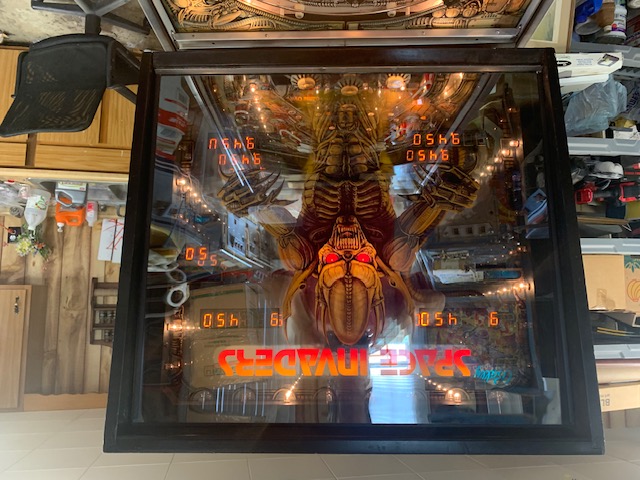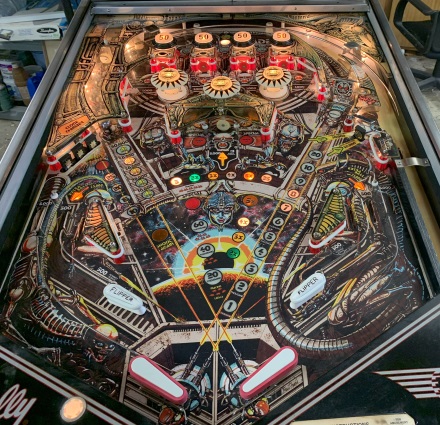Machine Statistics
Production Date: April 1980
Production Run: 11,400 units
Design: Jim Patla
Artwork: Paul Faris
The Game Synopsis/History
Space Invaders was a widebody game with infinity backglass lighting created by Bally loosely based on the Space Invaders video game. It was the first pinball machine based on a video game, which is kind of ironic, since video games would soon replace and almost doom pinball machines. The video game's theme can be seen in three aspects of the game. First, the artwork on the front of the cabinet contains renditions of the pixelated aliens as seen in the video game. Second, on the playfield there are five red alien targets and 5 blue rollover lanes that depict the aliens in the video game. Finally, the sounds for the game, while having more sounds than the video game, do incorporate some of the video game's sounds within the game play.
The bulk of the artwork on the playfield as well as the alien on the backglass have no connection to the video game. While the game came out before the release of the movie "Alien," it was determined that the backglass artwork was an unlicensed use of the alien depicted in the movie. As a result, Bally first halted production of the game. Bally then paid a licensing fee to 20th Century Fox and gave them three machines to use in its promotion of the second movie "Aliens." Despite having eerie similarities to the alien creature in the movie, most people rate the backglass artwork a 10+. It is considered one of the best backglasses of all time. With the "double-glass," infinity lighting, and superb artwork, the backglass is stunning.
The upper flippers were originally designed to be the longer 3" flippers, but it was determined that they prevented back hand shots from being made from the lower flippers so they were changed to the shorter 2" flippers. Unlike most games where the lowest scoring switches awarded 10 points, the lowest scoring switches on the playfield score in 50 pt. increments (4 passive pop bumpers, 5 rebound rubbers, 2 slings). Theoretically, you could get a score ending in something other than "00" or "50" if you tilted immediately after hitting one of the 50 pt. switches. One interesting note on this is that the match code still picked a number between "00" and "90" in 10 point increments. If you were playing a game with four players and the match came up as "00" or "50" you were gauranteed to match at least once and probably more.
The rules set is pretty straight forward, though there are a lot of options for a game from this era. There are 5 red alien stand up targets, one below each of the four passive bumpers and one in the center below the accelerator loop. Completing these advances the red alien bonus: 20k bonus for the first completion, 40k for the second, 60k for the third, and special thereafter. There are 5 blue alien rollover lanes, three at the top and then the two upper flipper inlane feeds. Making the top three lights the center rollover lane to score the same value as the clone chamber (captive ball). Making all five blue aliens lights the bottom 3" flipper inlanes for extra ball. Also, making the center rollover at the top lights the spinner for 1k. Note that nothing tells you that this is how you light the spinner.
On the left side there are three drop targets. Knocking them down scores the lit value and advances to the next: 10k, 15k, 20k, 25k, and special. Next going clockwise is the Clone Chamber (captive ball). Hitting this scores lit value and advances to the next: 10k, 20k, 30k, 40k, 50k. The center rollover at the top can be lit to score this as well. In the center of the playfield is the loop called the bonus accelerator. Going through the loop awards: 5k, 2X, 3X, 4X, 5X, and 25k. On the right is a single drop target. Knocking it down can be worth 50k. It also opens up the shooter lane and balls hit in there at the correct time will award the current bonus.
There was a short promotional comic that was distributed with the game. The comic is actually pretty cool and a unique way of promoting the game.
My Most Extensive Restoration
Of all the restorations that I have done, this one was the most extensive and time consuming. As usual, I will detail the work with explanations and then follow that with pictures, lots of pictures. But, in summary, here is some of the work I did which made this the most comprehensive restore I have done.
Hopefully, you can learn something from reading about what I did and seeing my work. Enjoy!
Brief Background On My Particular Game
This game somewhat worked when I got it in the lot of 19 games. For those who haven’t read the story on these games, I bought 19 classic games from the late 1970s to restore. All of the games were supposed to be working and I figured all I would be doing was restoring the cabinets and playfields. Well, only 5 of the games actually worked. Of those games, two remained to be restored, this one and a Bally Mystic. The Mystic is working great so I may not even restore it. So, this may be the last game I restore from that lot, some eighteen years later! To begin, I was able to get this game up and running without fixing or addressing all of the “issues” in the wiring, connectors, and boards. However, because this game was going to take a lot of time (this was the most comprehensive and time-consuming restoration I have done), I knew it would be the last game I restored. As a result, I ended up taking this game “out of service” and cannibalized parts to work on other games. Initially, to get the game working, all I did was get new game ROMS and install in the MPU. This allowed the MPU to boot and the game to play. But over time, I cannibalized the driver board and the displays for use in other games. Knowing the game wasn’t working, I proceeded to cut off the “MacGyvered” A3J3 connector. The game sat in this condition for over ten years before I started the restoration below.


